IQuS Publications
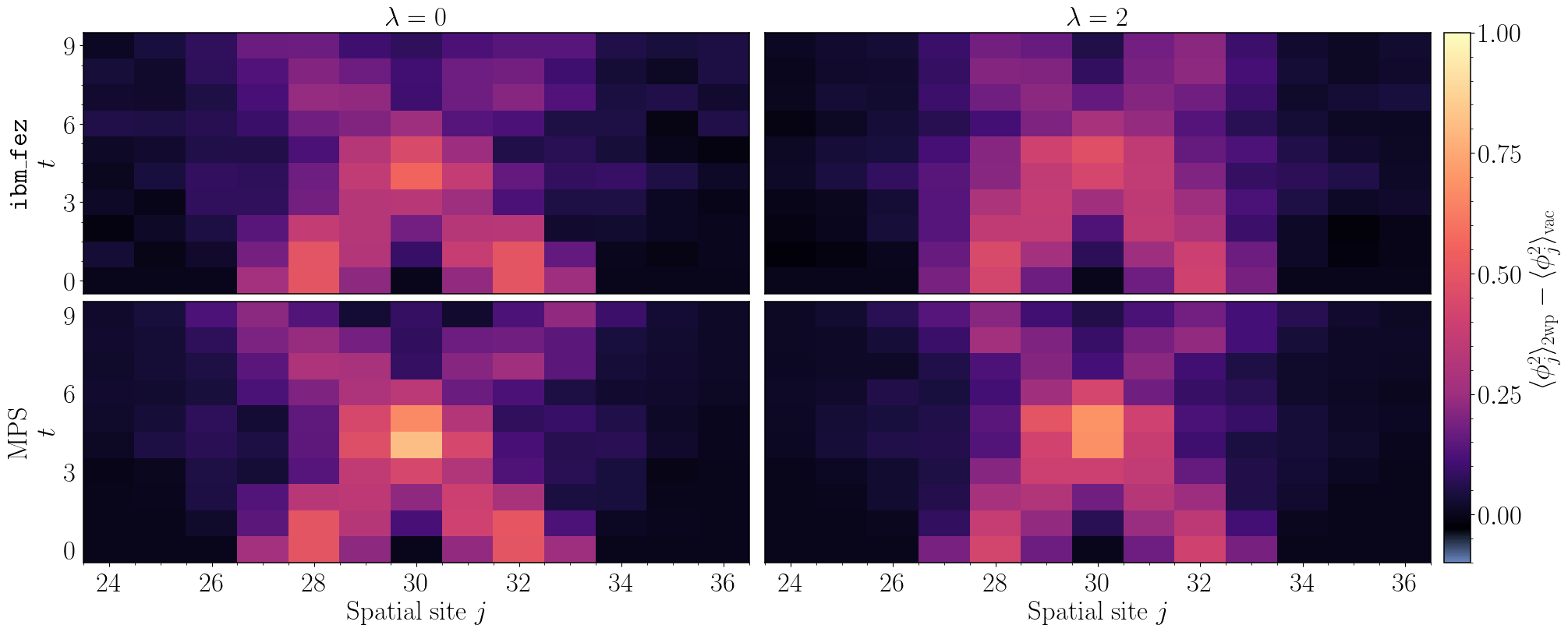
Scalable Quantum Simulations of Scattering in Scalar Field Theory on 120 Qubits
Simulations of collisions of fundamental particles on a quantum computer are expected to have an exponential advantage over classical methods and promise to enhance searches for new physics. Furthermore, scattering in scalar field theory has been shown to be BQP-complete, making it a representative problem for which quantum computation is efficient. As a step toward large-scale quantum simulations of collision processes, scattering of wavepackets in one-dimensional scalar field theory is simulated using 120 qubits of IBM’s Heron superconducting quantum computer ibm_fez. Variational circuits compressing vacuum preparation, wavepacket initialization, and time evolution are determined using classical resources. By leveraging physical properties of states in the theory, such as symmetries and locality, the variational quantum algorithm constructs scalable circuits that can be used to simulate arbitrarily-large system sizes. A new strategy is introduced to mitigate errors in quantum simulations, which enables the extraction of meaningful results from circuits with up to 4924 two-qubit gates and two-qubit gate depths of 103. The effect of interactions is clearly seen, and is found to be in agreement with classical Matrix Product State simulations. The developments that will be necessary to simulate high-energy inelastic collisions on a quantum computer are discussed.
The author thanks Roland Farrell, Marc Illa, Zhiyao Li, Henry Froland, Anthony Ciavarella, and Martin Savage for helpful discussions and insightful comments. This work was supported in part by the U.S. Department of Energy, Office of Science, Office of Nuclear Physics, InQubator for Quantum Simulation (IQuS) under Award Number DOE (NP) Award DE-SC0020970 via the program on Quantum Horizons: QIS Research and Innovation for Nuclear Science. This work was also supported, in part, through the Department of Physics and the College of Arts and Sciences at the University of Washington. This work has made extensive use of Wolfram Mathematica, python, julia, jupyter notebooks in the conda environment, IBM’s quantum programming environment qiskit, and iTensor in this work. This work was enabled, in part, by the use of advanced computational, storage and networking infrastructure provided by the Hyak supercomputer system at the University of Washington. This research was done using services provided by the OSG Consortium, which is supported by the National Science Foundation awards #2030508 and #1836650. The author acknowledges the use of IBM Quantum Credits for this work. The views expressed are those of the author, and do not reflect the official policy or position of IBM or the IBM Quantum team.
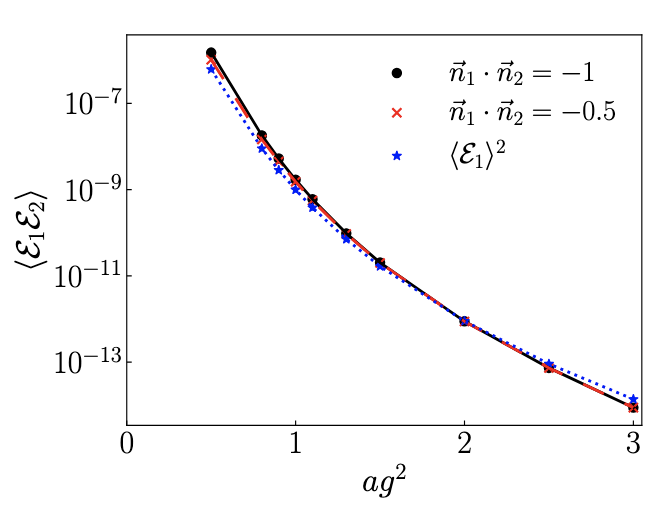
Quantum Computing for Energy Correlators
We study a quantum algorithm to calculate energy correlators for quantum field theories, which consists of ground state preparation, applying source, sink, energy flux and real-time evolution operators and Hadamard test. We discuss how to take the asymptotic detector limit in the Hamiltonian lattice approach. We then calculate the energy correlators for the SU(2) pure gauge theory in 2+1 dimensions on 3 x 3 and 5 x 5 honeycomb lattices with j_max=1/2 at fixed couplings, by using both classical methods and the quantum algorithm studied. The results obtained from the quantum algorithm and the IBM emulator are consistent with the classical methods’ results. We lay out the path forward for calculations in the physical limit.
K.L. was supported by the U.S. Department of Energy, Office of Science, Office of Nuclear Physics from DE-SC0011090. F.T. and X.Y. were supported by the U.S. Department of Energy, Office of Science, Office of Nuclear Physics, InQubator for Quantum Simulation (IQuS) (https://iqus.uw.edu) under Award Number DOE (NP) Award DE-SC0020970 via the program on Quantum Horizons: QIS Research and Innovation for Nuclear Science. This research used resources of the National Energy Research Scientific Computing Center (NERSC), a Department of Energy Office of Science User Facility using NERSC award NP-ERCAP0027114.
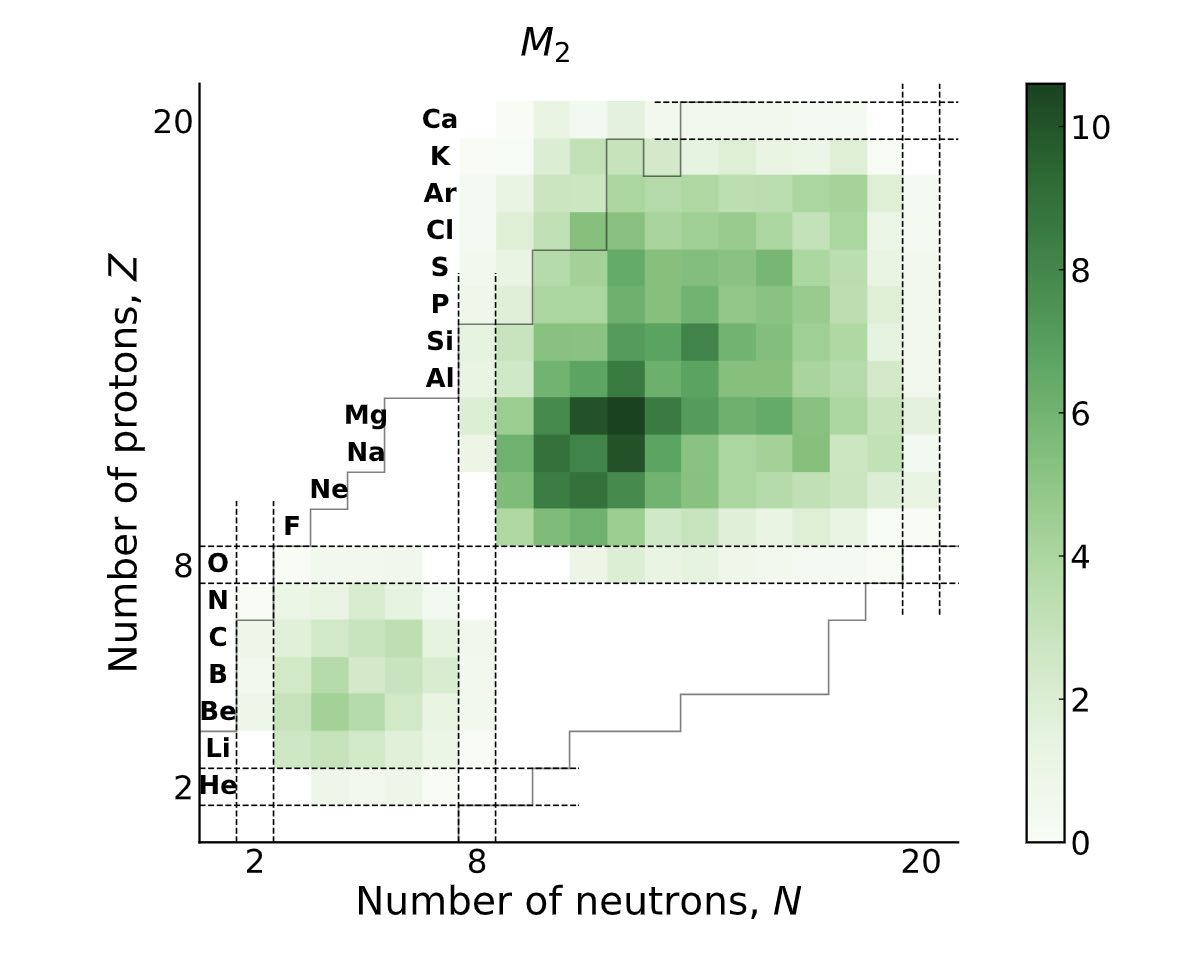
Quantum Magic and Multi-Partite Entanglement in the Structure of Nuclei
Motivated by the Gottesman-Knill theorem, we present a detailed study of the quantum complexity of p-shell and sd-shell nuclei. Valence-space nuclear shell-model wavefunctions generated by the BIGSTICK code are mapped to qubit registers using the Jordan-Wigner mapping (12 qubits for the p-shell and 24 qubits for the sd-shell), from which measures of the many-body entanglement (n-tangles) and magic (non-stabilizerness) are determined. While exact evaluations of these measures are possible for nuclei with a modest number of active nucleons, Monte Carlo simulations are required for the more complex nuclei. The broadly applicable Pauli-String I Z exact (PSIZe-) MCMC technique is introduced to accelerate the evaluation of measures of magic in deformed nuclei (with hierarchical wavefunctions), by factors of ∼ 8 for some nuclei. Significant multi-nucleon entanglement is found in the sd-shell, dominated by proton-neutron configurations, along with significant measures of magic. This is evident not only for the deformed states, but also for nuclei on the path to instability via regions of shape coexistence and level inversion. These results indicate that quantum-computing resources will accelerate precision simulations of such nuclei and beyond. [IQuS@UW-21-088]
This work was supported, in part, by Universität Bielefeld (Caroline, Federico), by the Deutsche Forschungsgemeinschaft (DFG, German Research Foundation) through the CRC-TR 211 ’Strong interaction matter under extreme conditions’– project number 315477589 – TRR 211 (Momme), by ERC-885281-KILONOVA Advanced Grant (Caroline), and by the MKW NRW under the funding code NW21-024-A (James). This work also supported by U.S. Department of Energy, Office of Science, Office of Nuclear Physics, InQubator for Quantum Simulation (IQuS)8 under Award Number DOE (NP) Award DE-SC0020970 via the program on Quantum Horizons: QIS Research and Innovation for Nuclear Science, and by the Department of Physics and the College of Arts and Sciences at the University of Washington (Martin). This research used resources of the National Energy Research Scientific Computing Center, a DOE Office of Science User Facility supported by the Office of Science of the U.S. Department of Energy under Contract No. DE-AC02- 05CH11231 using NERSC awards NP-ERCAP0027114 and NP-ERCAP0029601. Some of the computations in this work were performed on the GPU cluster at Bielefeld University. We thank the Bielefeld HPC.NRW team for their support. This research was also partly supported by the cluster computing resource provided by the IT Department at the GSI Helmholtzzentrum für Schwerionenforschung, Darmstadt, Germany.

A Fully Gauge-Fixed SU(2) Hamiltonian for Quantum Simulations
We demonstrate how to construct a fully gauge-fixed lattice Hamiltonian for a pure SU(2) gauge theory. Our work extends upon previous work, where a formulation of an SU(2) lattice gauge theory was developed that is efficient to simulate at all values of the gauge coupling. That formulation utilized maximal-tree gauge, where all local gauge symmetries are fixed and a residual global gauge symmetry remains. By using the geometric picture of an SU(2) lattice gauge theory as a system of rotating rods, we demonstrate how to fix the remaining global gauge symmetry. In particular, the quantum numbers associated with total charge can be isolated by rotating between the lab and body frames using the three Euler angles. The Hilbert space in this new “sequestered” basis partitions cleanly into sectors with differing total angular momentum, which makes gauge-fixing to a particular total charge sector trivial, particularly for the charge-zero sector. In addition to this sequestered basis inheriting the property of being efficient at all values of the coupling, we show that, despite the global nature of the final gauge-fixing procedure, this Hamiltonian can be simulated using quantum resources scaling only polynomially with the lattice volume.
DMG is supported in part by the U.S. Department of Energy, Office of Science, Office of Nuclear Physics, InQubator for Quantum Simulation (IQuS) (https://iqus.uw.edu) under Award Number DOE (NP) Award DE-SC0020970 via the program on Quantum Horizons: QIS Research and Innovation for Nuclear Science. DMG is supported, in part, through the Departmen of Physics and the College of Arts and Sciences at the University of Washington. CFK is supported in part by the Department of Physics, Maryland Center for Fundamental Physics, and the College of Computer, Mathematical, and Natural Sciences at the University of Maryland, College Park. This material is based upon work supported by the U.S. Department of Energy, Office of Science, Office of Advanced Scientific Computing Research, Department of Energy Computational Science Graduate Fellowship under Award Number DE-SC0020347. CWB was supported by the DOE, Office of Science under contract DE-AC02-05CH11231, partially through Quantum Information Science Enabled Discovery (QuantISED) for High Energy Physics (KA2401032)
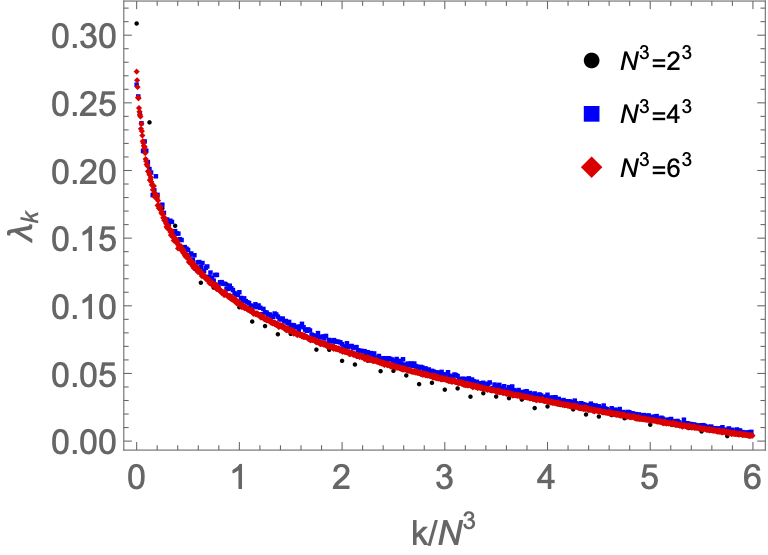
The Nonabelian Plasma is Chaotic
Nonabelian gauge theories are chaotic in the classical limit. We discuss new evidence from SU(2) lattice gauge theory that they are also chaotic at the quantum level. We also describe possible future studies aimed at discovering the consequences of this insight. Based on a lecture presented by the first author at the Particles and Plasmas Symposium 2024.
The authors gratefully acknowledge the scientific support and HPC resources provided by the Erlangen National High Performance Computing Center (NHR@FAU) of the Friedrich-Alexander-Universit ̈at Erlangen-Nurnberg (FAU) under the NHR project b172da-2. NHR funding is provided by federal and Bavarian state authorities. NHR@FAU hardware is partially funded by the German Research Foundation (DFG 440719683). BM and XY acknowledge support from the U.S. Department of Energy, Office of Science, Nuclear Physics (awards DE-FG02-05ER41367 and DE-SC0020970).
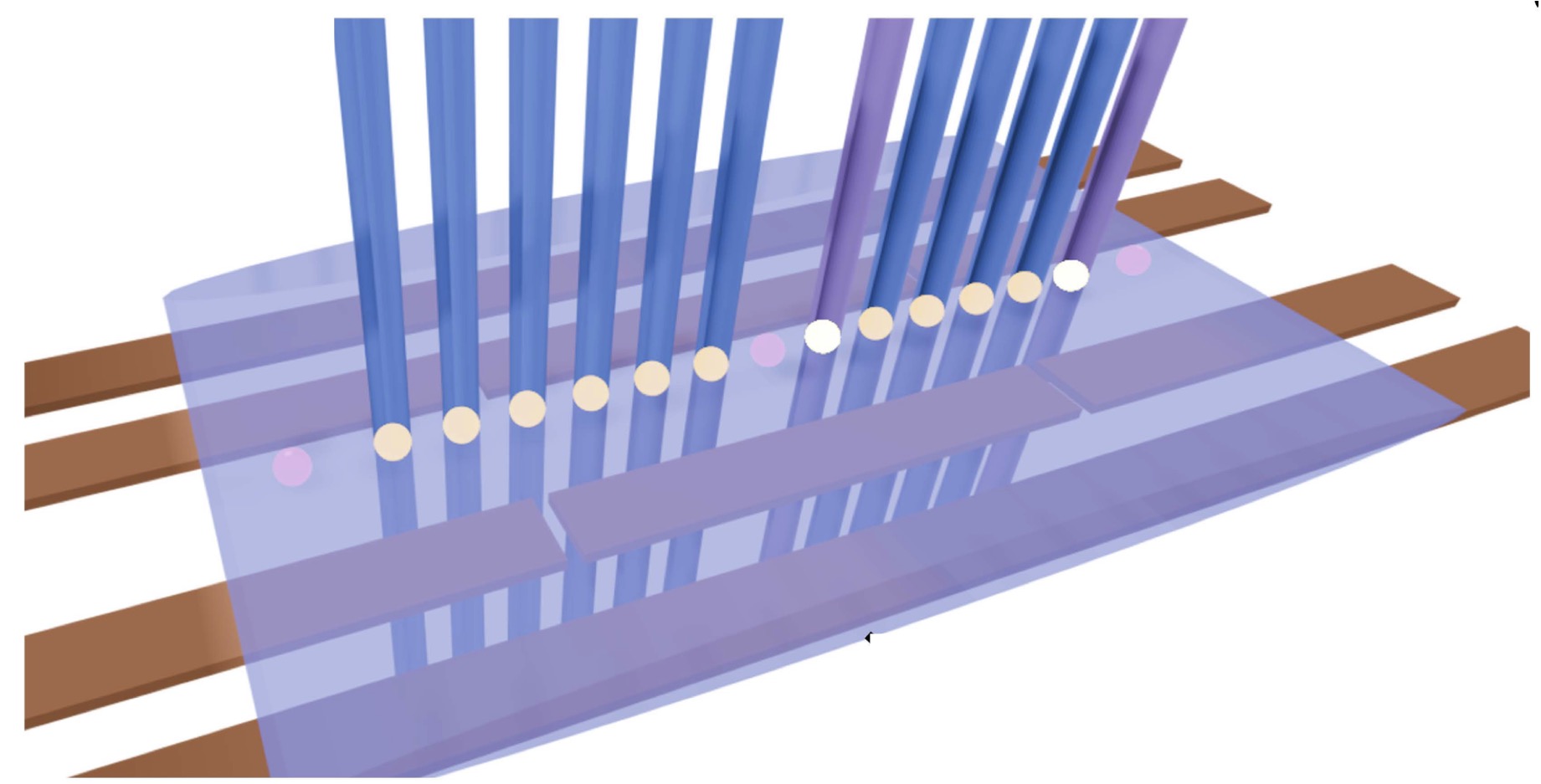
Quantum Computing Universal Thermalization Dynamics in a (2+1)D Lattice Gauge Theory
Simulating nonequilibrium phenomena in strongly-interacting quantum many-body systems, including thermalization, is a promising application of near-term and future quantum computation. By performing experiments on a digital quantum computer consisting of fully-connected optically-controlled trapped ions, we study the role of entanglement in the thermalization dynamics of a Z2 lattice gauge theory in 2+1 spacetime dimensions. Using randomized-measurement protocols, we efficiently learn a classical approximation of nonequilibrium states that yields the gap-ratio distribution and the spectral form factor of the entanglement Hamiltonian. These observables exhibit universal early-time signals for quantum chaos, a prerequisite for thermalization. Our work, therefore, establishes quantum computers as robust tools for studying universal features of thermalization in complex many-body systems, including in gauge theories.
This work is supported by the DOE, Office of Science, Office of Nuclear Physics, IQuS (\url{https://iqus.uw.edu}), via the program on Quantum Horizons: QIS Research and Innovation for Nuclear Science under Award DE-SC0020970 and by the National Science Foundation’s Quantum Leap Challenge Institute for Robust Quantum Simulation under Award OMA-2120757 and by the Department of Energy’s (DOE’s) QDOE Office of Science Early Career Award DE-SC0020271
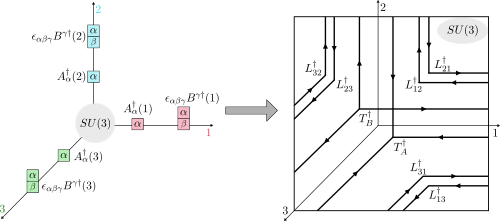
Loop-string-hadron approach to SU(3) lattice Yang-Mills theory: Gauge invariant Hilbert space of a trivalent vertex
The construction of gauge invariant states of SU(3) lattice gauge theories has garnered new interest in recent years, but implementing them is complicated by the difficulties of SU(3) Clebsch-Gordon coefficients. In the loop-string-hadron (LSH) approach to lattice gauge theories, the elementary excitations are strictly gauge invariant, and constructing the basis requires no knowledge of Clebsch-Gordon coefficients. Originally developed for SU(2), the LSH formulation was recently generalized to SU(3), but limited to one spatial dimension. In this work, we generalize the LSH approach to constructing the basis of SU(3) gauge invariant states at a trivalent vertex — the essential building block to multidimensional space. A direct generalization from the SU(2) vertex yields a legitimate basis; however, in certain sectors of the Hilbert space, the naive LSH basis vectors so defined suffer from being nonorthogonal. The issues with orthogonality are directly related to the “missing label” or “outer multiplicity” problem associated with SU(3) tensor products, and may also be phrased in terms of Littlewood-Richardson coefficients or the need for a “seventh Casimir” operator. The states that are unaffected by the problem are orthonormalized in closed form. For the sectors that are afflicted, we discuss the nonorthogonal bases and their orthogonalization. A few candidates for seventh Casimir operators are readily constructed from the suite of LSH gauge-singlet operators. The diagonalization of a seventh Casimir represents one prescriptive solution towards obtaining a complete orthonormal basis, but a closed-form general solution remains to be found.
Work by JRS was supported by the U.S. Department of Energy (DOE), Office of Science under contract DE-AC02-05CH11231, partially through Quantum Information Science Enabled Discovery (QuantISED) for High Energy Physics (KA2401032). JRS and SK both received sup- port from the U.S. Department of Energy’s Office of Science Early Career Award under award DE-SC0020271, for theoretical developments for simulating lattice gauge theories on quantum computers. SK acknowledges support by the U.S. DOE, Office of Science, Office of Nuclear Physics, InQubator for Quantum Simulation (IQuS) (award no. DE-SC0020970), and by the DOE QuantISED program through the theory consortium “Intersections of QIS and Theoretical Particle Physics” at Fermilab (Fermilab subcontract no. 666484). SK further acknowledges the support from the Department of Physics and the College of Arts and Sciences at the University of Washington. Research of IR is supported by the OPERA award (FR/SCM/11 Dec-2020/PHY) from BITS-Pilani, the Start-up Research Grant (SRG/2022/000972) and Core-Research Grant (CRG/2022/007312) from ANRF, India and the cross-discipline research fund (C1/23/185) from BITS-Pilani. AN is supported by the Start-up Research Grant (SRG/2022/000972) from ANRF, India received by IR.

Sequency Hierarchy Truncation (SeqHT) for Adiabatic State Preparation and Time Evolution in Quantum Simulations
We introduce the Sequency Hierarchy Truncation (SeqHT) scheme for reducing the resources required for state preparation and time evolution in quantum simulations, based upon a truncation in sequency. For the λφ4 interaction in scalar field theory, or any interaction with a polynomial expansion, upper bounds on the contributions of operators of a given sequency are derived. For the systems we have examined, observables computed in sequency-truncated wavefunctions, including quantum correlations as measured by magic, are found to step-wise converge to their exact values with increasing cutoff sequency. The utility of SeqHT is demonstrated in the adiabatic state preparation of the λφ4 anharmonic oscillator ground state using IBM’s quantum computer ibm_sherbrooke. Using SeqHT, the depth of the required quantum circuits is reduced by ∼ 30%, leading to significantly improved determinations of observables in the quantum simulations. More generally, SeqHT is expected to lead to a reduction in required resources for quantum simulations of systems with a hierarchy of length scales.
This work was supported in part by the U.S. Department of Energy, Office of Science, Office of Nuclear Physics, InQubator for Quantum Simulation (IQuS) (https://iqus.uw.edu) under Award Number DOE (NP) Award DE-SC0020970 via the program on Quantum Horizons: QIS Research and Innovation for Nuclear Science. This work was supported, in part, through the Department of Physics and the College of Arts and Sciences at the University of Washington. We acknowledge the use of IBM Quantum services for this work.
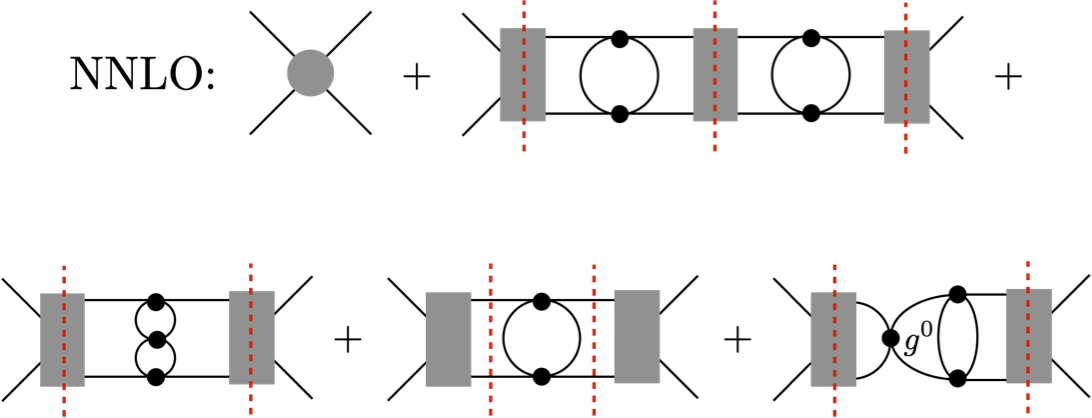
Universal corrections to the superfluid gap in a cold Fermi gas
A framework for computing the superfluid gap in an effective field theory (EFT) of fermions interacting via momentum independent contact forces is developed. The leading universal corrections in the EFT are one-loop in-medium effects at the Fermi surface, and reproduce the well-known Gor’kov-Melik-Barkhudarov result. The complete subleading universal corrections are presented here, and include one-loop effects away from the Fermi surface, two-loop in-medium effects, as well as modifications to the fermion propagator. Together, these effects are found to reduce the gap at low densities. Applications to neutron superfluidity in neutron stars are discussed.
This work was supported by the Swiss National Science Foundation (SNSF) under grant numbers 200021_192137 and PCEFP2_203335, by the U. S. Department of Energy grant DE-FG02-97ER-41014 (UW Nuclear Theory) and by the U. S. Department of Energy grant DE-SC0020970, (InQubator for Quantum Simulation).
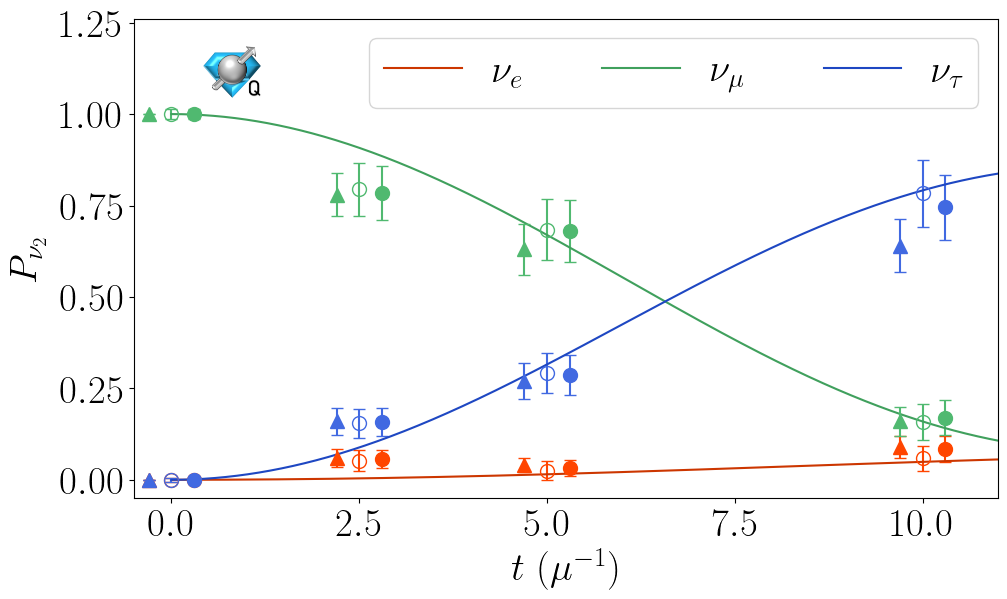
Qutrit and Qubit Circuits for Three-Flavor Collective Neutrino Oscillations
We explore the utility of qutrits and qubits for simulating the flavor dynamics of dense neutrino systems. The evolution of such systems impacts some important astrophysical processes, such as core-collapse supernovae and the nucleosynthesis of heavy nuclei. Many-body simulations require classical resources beyond current computing capabilities for physically relevant system sizes. Quantum computers are therefore a promising candidate to efficiently simulate the many-body dynamics of collective neutrino oscillations. Previous quantum simulation efforts have primarily focused on properties of the two-flavor approximation due to their direct mapping to qubits. Here, we present new quantum circuits for simulating three-flavor neutrino systems on qutrit- and qubit-based platforms, and demonstrate their feasibility by simulating systems of two, four and eight neutrinos on IBM and Quantinuum quantum computers.
This work was supported, in part, by U.S. Department of Energy, Office of Science, Office of Nuclear Physics, InQubator for Quantum Simulation (IQuS)9 under DOE (NP) Award No. DE-SC0020970 via the program on Quantum Horizons: QIS Research and Innovation for Nuclear Science (Turro, Bhaskar, Chernyshev), and the Quantum Science Center (QSC) which is a National Quantum Information Science Research Center of the U.S. Department of Energy (DOE) (Illa). This work is also supported, in part, through the Department of Physics12 and the College of Arts and Sciences at the University of Washington. This research used resources of the Oak Ridge Leadership Computing Facility (OLCF), which is a DOE Office of Science User Facility supported under Contract DE-AC05-00OR22725. We acknowledge the use of IBM Quantum services for this work.


